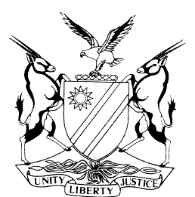4
REPUBLIC OF NAMIBIA

IN THE HIGH COURT OF NAMIBIA, MAIN DIVISION, WINDHOEK
REVIEW JUDGMENT
Case Title: The State v Willem Jacobus van Rooi | CR no: 67/2022 | |
High Court MD Review No: 8121/2022 | Division of Court: Main Division | |
Heard before: Judge Shivute et Judge January | Delivered on: 29 July 2022 | |
Neutral citation: S v van Rooi (CR 67/2022) [2022] NAHCMD 382 (29 July 2022) | ||
The order:
| ||
Reasons for order: | ||
JANUARY J (SHIVUTE J concurring) [1] This is a review matter submitted from the Mariental Magistrate’s Court in terms of s 302(1) of the Criminal Procedure Act 51 of 1977, as amended (the CPA). [2] The accused appeared on a charge of contravening s 82(1)(b) read with ss 1, 86, 89(1) and 89(4) of the Road Traffic and Transportation Act 22 of 1999 (the Act) – Driving with an excessive blood-alcohol level. The charge alleges: ‘that on or about the 13th of January 2021 at or near a public road, namely Cornelius Isaacks section at or near Police Barracks in the district of Mariental, the said accused did wrongfully and unlawfully drive a vehicle with registration number unknown while the concentration of alcohol in his blood was not less than 0.08 gram per 100 millilitres, to wit: 0,19 gram per 100 millilitres.’ [3] The accused pleaded guilty to the charge, was questioned in terms of s 112(1)(b) of the CPA, where after he was convicted. He was sentenced to a fine of N$1000 or six months’ imprisonment. [4] A query was directed to the magistrate to explain how he was satisfied that the blood was withdrawn within two hours after the alleged offence. No questions relating to this element was asked and no answers emerged to this fact. [5] In addition, the review coversheet and J15 charge sheet wrongly reflect, where the sentence was supposed to be, that count one was withdrawn and the crime that the accused was convicted for. [6] The mistakes were corrected in the meantime. The magistrate correctly conceded that he should have questioned the accused on the issue. He requested that the matter should be remitted to be rectified. [7] S 112(1)(b) of CPA questioning has a twofold purpose, namely to establish the factual basis for the plea of guilty and to establish the legal basis for such plea. From the admissions, the court must conclude whether the legal requirements for the commission of the offence have been met. These include questions of unlawfulness, actus reus and mens rea. The court can only satisfy itself if all the admissions adequately cover all the elements of the offence. [8] The relevant section of the Act provides as follows: ‘82 Driving under the influence of intoxicating liquor or drugs having narcotic effect, or with excessive amount of alcohol in blood or breath
(a) . . . (b) . . . (2) No person shall on a public road (a) drive a vehicle; or (b) occupy the driver's seat of a motor vehicle of which the engine is running, while the concentration of alcohol in any specimen of blood taken from any part of his or her body exceeds 0,079 grams per 100 millilitres. (3) Where in any prosecution for an offence under subsection (2), it is proved that the concentration of alcohol in any specimen of blood taken from any part of the body of the person concerned exceeded 0,079 grams per 100 millilitres at any time within two hours after the alleged offence, it shall be presumed, in the absence of evidence to the contrary, that such concentration exceeded 0,079 grams per 100 millilitres at the time of the alleged offence.’ (my underlining). [9] It is thus, imperative that the magistrate must be satisfied that the blood was withdrawn within two hours from the time that the offence was allegedly committed. [10] In the result:
| ||
H C JANUARY JUDGE | N N SHIVUTE JUDGE | |